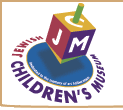|
A Children's Museum
Since the first children's museum was founded in Brooklyn, New York in 1899, the field's fundamental philosophy has remained remarkably unchanged: Belief in participatory learning and in teaching children about themselves and the world around them. The individual ways in which each museum interprets this mission varies widely. Some focus on a single subject (art, science) or a target age group (early childhood; primary school age). Many are interdisciplinary, using a wide range of exhibit techniques, from the creation of environments to foster learning through play, to more traditional exhibits featuring artifacts and interactive devices. Most are not collection-based but use objects for teaching and in exhibits. The fundamental difference between children's museums and all others is quite simply their focus on children.
Children's museums define themselves as audience centered, and are driven by how children learn in an informal learning environment. Therefore, what makes for a good children's museum is knowing about, and meeting the needs of its young visitors. This requires extensive knowledge of child development and the museum's community. Additionally, children's museums develop interactive exhibits that lead to learning through direct experiences. This involves all the senses, along with a variety of techniques to reach all types of intelligences (as defined by Harvard psychologist/author, Howard Gardner: Physical, spatial, mathematic, linguistic, inter and intra-personal and musical). Public programs are similarly developed.
It is said that children's museums also teach about museum-going: How to use the learning opportunities provided by museums, and about integrating these unique educational/recreational institutions into their lives. Artistic excellence, design, research and evaluation are as important in a children's museum as any other museum. Added to this list is a conscious effort to inspire, to spark imagination, and to help children learn how to learn. Research has proven that repeat visitors to children's museums have the capacity to improve school performance, discover new areas of interest, and increase self-esteem.
The informal and welcoming atmosphere of children's museums attracts many first time museum visitors, as well as those who would not typically consider museums as a leisure time or educational activity for their family. Children's museums serve to unite communities around the common bond of a focus on the needs of young people.
Finally, scores of children's museums have been founded in the past twenty-five years inspired by the success of others, and by the need for relevant cultural and educational programming for children and families. There are over four hundred such museums in the United States and a growing number around the world. Four youth museums are located in New York City, one within blocks of the Jewish Children’s Museum, and another six within an hour’s reach of the city. The Jewish Children’s Museum has joined this community of innovative educational institutions. It will be one of a very small group of ethnically focused youth museums, joining two other Jewish Children’s Museums, both in early formation.
|





